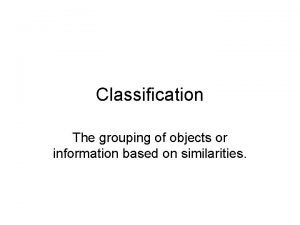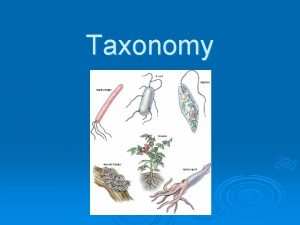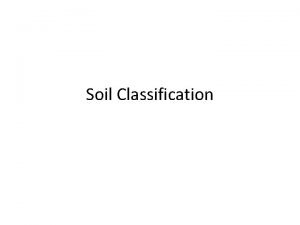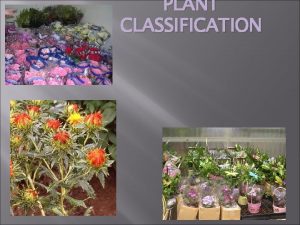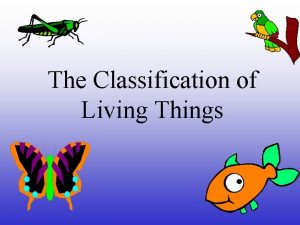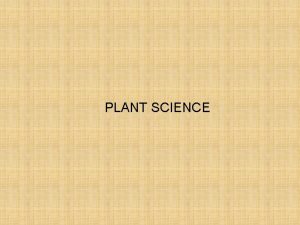Principales of Plant systematic Classification Grouping of living




![● III – Kingdom: Protista ● [Eukaryotic thalli, mostly contain chlorophyll (Autotrophy)] ● ● ● III – Kingdom: Protista ● [Eukaryotic thalli, mostly contain chlorophyll (Autotrophy)] ● ●](https://slidetodoc.com/presentation_image_h2/e9707040122e590749f561bc717628ff/image-5.jpg)







- Slides: 12

Principales of Plant systematic Classification: • Grouping of living things are sorted into groups to order them. History of classification: • Aristotle (384 -322 BC) divided the living world into 2 kingdoms (Plants & animals) and persisted for over 2000 years (Binomial classification). • Hogg and Haeckel (1860) in the 19 th contury added a third kingdom with no tissues and named it Protista (bacteria & Algae and Fungi). • Copeland (1938) divided kingdom Protista into 2 kingdoms: (1) Monera (unicellular prokaryotic = bacteria): (2) Protista (Algae + Fungi).

Five-kingdom classification: • Wittaker (1969) suggested (The five-kingdom Classification scheme). He divided living organisms into five kingadoms: Monera, Protista, Fungi, Plantae and Animalia. This five kingdoms Classification includes three kingdoms: (1) feed by photosynthesis (Kingdom Plantae), (2) Food swallowing (Kingdom Animalia), (3) food absorption from the media (Kingdom Fungi); in addition to another two kingedom, (4) Kingdom Monera (Prokaryotic) and (5) kingdom Protista (eukaryotic).

Classification of living organisms into five kingdoms according differences in their characters, Kingdom Character The cell Shape Nutrition motion Monera Prokaryotic One cell Heterotrophic Some of them move by flagella Protista Eukaryotic Mostly one cell Autophototrophic Some of them move by flagella or cillia Fungi Eukaryotic Multicellular Heterotrophic Immobile Plantae Eukaryotic Multicellular Autophototrophic Immobile Animalia Eukaryotic Multicellular Heterotrophic as food swallowing Movement by contracted fibers N. B. : Viruses are non cellular structures which have living and non living characters; therefore, they are not enrolled under this classification.

Classification of plant organisms: • • • • I – Kingdom: Monera (Unicellular prokaryotic microorganisms). Division: Eubacteriophyta Class 1: Eubacteriae Class 2: Cyanobacteriae I – Kingdom: Fungi [Eucaryotic thalli do not have chlorophyll (Heterotrophy)] Division 1: Myxomycota Division 2: Eumycota Class 1: Oomycetes Class 2: Zygomycetes Class 3: Ascomycetes Class 4: Basidiomycetes Class 5: Deuteromycetes Class 6: Lichenes (Lichens)
![III Kingdom Protista Eukaryotic thalli mostly contain chlorophyll Autotrophy ● III – Kingdom: Protista ● [Eukaryotic thalli, mostly contain chlorophyll (Autotrophy)] ● ●](https://slidetodoc.com/presentation_image_h2/e9707040122e590749f561bc717628ff/image-5.jpg)
● III – Kingdom: Protista ● [Eukaryotic thalli, mostly contain chlorophyll (Autotrophy)] ● ● Division 1: Euglenophyta (Euglenoids) Division 2: Chlorophyta (Green Algae) Division 3: Chrysophyta (Yellow Green Algae) Division 4: Phaeophyta (Brown Algae) Division 5: Rhodophyta (Red Algae) ● VI – Kingdom: Plantae ● ● ● (Plants have two stages of life cycles, one of them is called gametophyte and the second is named sporophyte which carries spores. Alternation of generation is well kingdom in this kingdom). Division 1: Bryophyta ﻗﺴﻢ ﺍﻟﺤﺰﺍﺯﻳﺎﺕ Division 2: Pterophyta (Ferns) ﻗﺴﻢ ﺍﻟﺘﺮﻳﺪﺍﺕ Division 3: Anthophyta (flowering plants) ﻗﺴﻢ ﺍﻟﻨﺒﺎﺗﺎﺕ ﺍﻟﺰﻫﺮﻳﺔ Class 1: Monocotyledonae (Monocots) ﻃﺎﺋﻔﺔ ﺍﻟﻨﺒﺎﺗﺎﺕ ﺫﻭﺍﺕ ﺍﻟﻔﻠﻘﺔ ﺍﻟﻮﺍﺣﺪﺓ Class 2: Dicotyledonae (Dicots) ﻃﺎﺋﻔﺔ ﺍﻟﻨﺒﺎﺗﺎﺕ ﺫﻭﺍﺕ ﺍﻟﻔﻠﻘﺘﻴﻦ

VIRUSES Discovery and characteristics: • Iwanowski (19 th centry), pressed some sap from a diseased tobacco plant into a healthy tobacco plant. • The healthy plant soon developed signs of a disease similar to that of the plant from which the sap was taken. • The experiment was repeated, but this time the sap from the diseased plant was passed through a bacterial filter. The healthy plants inoculated with this filtered sap also showed signs of the disease of the original plant. This was a new discovery; a disease could be transmitted from one plant to another by a filtered sap that was free of visible living bodies even when viewed by the most powerful light microscopes. This means that the sap contains something other than bacteria that causes the disease.

The Nature of a Virus: • * Viruses are small particles, less than 0. 2 of a micron in diameter. * obligate parasites. * Viruses do not possess enzyme systems. Viral constituents are similar to those of their hosts and viruses may cause the enzyme systems of the host to synthesize virus materials, rather than host, materials. Therefore they cannot exist outside of cells. *Virus particles also exist outside the cells where they may be considered as non living chemicals. They enter into living cells where they multiply and mostly causing diseases. Viruses then, are true infectious agents. Inside the host cell they may become incorporated in the metabolism of the host cell and be transmitted from one cell to another. * In many cases the presence of a virus in a host cell may protect it against infection with similar virus a phenomenon known as (cross protection). * They exist in various shapes such as spherical particles, brick shaped particles or as more complicated structures. They cannot be classified by their morphology as we do many living organisms.





 The grouping of objects based on similarities
The grouping of objects based on similarities Taxonomic classification
Taxonomic classification The grouping of objects based on similarities
The grouping of objects based on similarities Living and nonliving things venn diagram
Living and nonliving things venn diagram Is a seed living or nonliving
Is a seed living or nonliving Living non living dead
Living non living dead The smallest living unit of all living things is
The smallest living unit of all living things is Introduction in plant breeding
Introduction in plant breeding Taichum
Taichum Plant introduction in plant breeding
Plant introduction in plant breeding Tronsmo plant pathology and plant diseases download
Tronsmo plant pathology and plant diseases download Tronsmo plant pathology and plant diseases download
Tronsmo plant pathology and plant diseases download Tronsmo plant pathology and plant diseases download
Tronsmo plant pathology and plant diseases download
